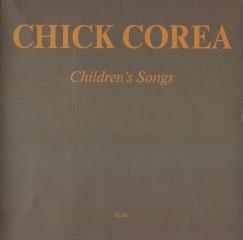Chick Corea – Children’s Songs (1984)
Chick Corea – Children’s Songs (1984)

1. "No.1"
2. "No.2"
3. "No.3"
4. "No.4"
5. "No.5"
6. "No.6"
7. "No.7"
8. "No.8"
9. "No.9"
10. "No.10"
11. "No.11"
12. "No.12"
13. "No.13"
14. "No.14"
15. "No.15"
16. "No.16 & 17"
17. "No.18"
18. "No.19"
19. "No.20"
20. "Addendum" - (for violin, cello and piano)
Chick Corea - Piano
Fred Sherry - Cello
Ida Kavafian – Violin
When one thinks of children's songs, "Old McDonald," "Mary Had a Little Lamb," "Itsy Bitsy Spider" or "Frere Jacques" come immediately to mind, but not for Chick Corea. These solo piano works are sophisticated instead of simplistic and cute, exhibiting the playful, innocent, wide-eyed aspect of our universal childhoods. Infusing his at times devilish, often bouncy and ultra-melodic sense of wonder and discovery, Corea's distinctive style and virtuosic techniques are hard to mistake for anyone else. Nineteen solo piano excursions comprise 20 separate ideas from Corea's fertile imagination, childlike in essence but mature in execution. It is as if he is wandering through various stages of birth, self-awareness, discovery, adolescence, and early teen pre-pubescence. There's a real sense of learning, growth, and true understanding progressively strewn through these pieces. Fans of Corea and Return to Forever will readily recognize three of these themes; the repeated, slightly dark construct of "No. 1," the quick waltz melody of "No. 3," and the playful, circular motif on "No. 6." They all have been previously employed by the pianist in his most famous melodic songs of the '70s. Offering the most contrast aside from his signature sounds is the Steve Reich minimalism of "No. 4," the one-note based "No. 14" parallel to the Christmas tune "Joy to the World," and the ominous suggestions in the waltz of "No. 15." Corea mixes up every piece stylistically, whether in a lilting, two fisted, stoic, delicate, spastic, quirky, ascending and descending or rumbling and rambling mood. The lone combo track "No. 16/17" progresses from one-note chords to dramatic rumination and impressive arpeggios, then merges into an eyelash winking, pretty innocence. He's surprisingly muted, quiet, and restrained during "No. 18," then flashes fast and furious on the utterly ingenious "No. 19." The finale, "No. 20," is set in a Baroque chamber trio with the great classical violinist Ida Kavafian leading the way, with Corea and cellist Fred Sherry blissfully following along. Very few pianists can carry off the original solo piano program that Corea tenders on this delightful collection that reminds all of us not only of our best moments of childhood, but those days that still reflect the inner child in our grown-up years. --- Michael G. Nastos, All Music Guide
download (mp3 @320 kbs):
yandex mediafire ulozto gett solidfiles
Zmieniony (Piątek, 12 Luty 2021 16:53)








